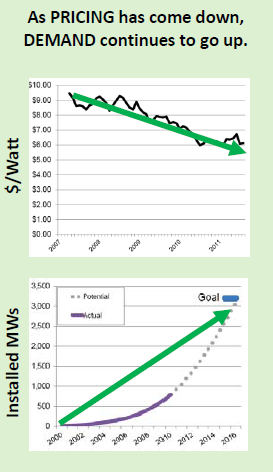The Georgia version, according to GEFA:
As you can see by GEFA’s pie chart, solar energy was too small to chart as a source of energy in Georgia as of 2004. With solar, we can burn less coal and uranium.Net metering is the process whereby an energy consumer produces energy and then sells some or all of this energy to the “grid”, or major energy producers in the state. Under Georgia’s net metering laws, state residents and businesses can purchase and operate green energy capital, including photovoltaics, wind energy and fuel cells, and use this energy on-site. These residents and businesses may then sell any un-used, additional energy produced on-site to their energy provider. There is a maximum of 10 kilowatts (kW) for residential applications and up to 100 kW for commercial applications.
Solar Energy Industries Association (SEIA) has a report, Solar Net Metering in California,
Protecting Net energy metering (NEM) is the top policy priority of the Solar Energy Industries Association (SEIA) for California in 2012. NEM is a billing arrangement that allows utility customers to offset some or all of their energy use (up to 1 MW) with selfgenerated renewable energy.The definition sounds the same, except for the cap: 1 megawatt is 1000 kilowatts, so California’s current cap is 100 times the Georgia residential cap and 10 times the Georgia commercial cap, with apparently no distinction between residential and commercial.
The result is this:
A state with a high goal for distributed energy generation! We could do that right here in Georgia.The California Net Metering Program is Working:

- 1 Gigawatt of Solar Installed – NEM has empowered more than 100,000 California ratepayers to go solar. NEM is necessary to achieve Governor Brown’s 12 GW Distributed Generation goal.
As prices go down, demand goes up!
- Solar Prices Have Declined – In California, the average cost of a public sector or commercial solar systems have dropped more than 40% and residential pricing has declined by over 25% since January 2007.
- Public Sector Savings – Public agencies will save a total of $2.5 billion in electricity costs over the 30 years of expected operation of Net Metered systems installed under the California Solar Initiative
 As
Dr. Sidney Smith has demonstrated,
counties or municipalities can even become financially self-sufficient
by this means.
As
Dr. Sidney Smith has demonstrated,
counties or municipalities can even become financially self-sufficient
by this means.
So much for Georgia Power’s disinformation campaign.
- No Cost Shift – Any cost shift from NEM is largely an artifact of the tiered residential rate design that is mandated by law. There is little or no cost shift from TOU rates or from commercial and industrial rates. The previous CPUC cost-benefit analysis, which used 2008 rates is outdated and showed that the bulk of the costs of net metering are from PG&E’s residential customers who had steeply tiered rates in 2008 that no longer exist. Even using the outdated calculations, the estimated rate impact of achieving 2.6 GW of installed NEM systems is only 0.38% of IOU revenues, or an average rate increase of $0.00064 per kWh. A comprehensive analysis would reveal there is no cost shift.
Meanwhile in California, net metering helps the middle class go solar and creates jobs: SEIA estimates 25,000 solar jobs in California.
That plus $10 billion in private investment. Imagine if instead of paying Georgia Power monthly for Construction Work in Progress (CWIP) for the nuclear Plant Vogtle boondoggle that the same amount went to solar construction. Imagine if you could invest in your own solar generation and sell the power to whomever you pleased. We can make that happen in Georgia.
And it would help if we could raise this:
Aggregate Capacity Limit: 0.2% of utility’s peak demand during previous yearMeanwhile in California:
Net energy metering in California has a program cap of 5% of aggregate customer peak demand.Once again California’s limit is far higher than Georgia’s, for this cap 25 times higher.
And the main point of SEIA’s report is to recommend raising the California cap by changing the way it is calculated to be more fair.
 In California, the revised cap calculation would raise
the GW PG&E would buy from 2.5 GW to 4.6 GW.
That’s 600 MW more power, and around 50,000 more jobs.
And that’s just for PG&E.
In California, the revised cap calculation would raise
the GW PG&E would buy from 2.5 GW to 4.6 GW.
That’s 600 MW more power, and around 50,000 more jobs.
And that’s just for PG&E.
Time to raise the cap in Georgia, and time for Georgia Power to expand its buyback program. And time for Georgia Power to get out of the way of power purchase agreements for solar generators selling electricity to whomever they please.
-jsq
Short Link: